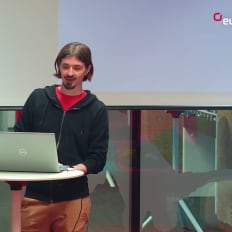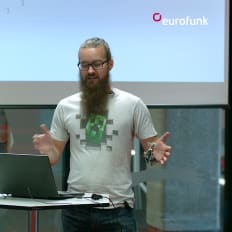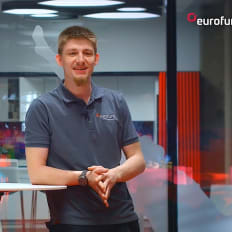
eurofunk Kappacher GmbH
From Sound to Sense
Description
Sabine Hasenleithner von eurofunk Kappacher spricht in ihrem devjobs.at TechTalk über die technischen Hintergründe von Sprach Erkennung im Notruf Kontext und zeigt in einer Live Demo eine mögliche Implementierung.
By playing the video, you agree to data transfer to YouTube and acknowledge the privacy policy.
Video Summary
In From Sound to Sense, Sabine Hasenleithner (eurofunk Kappacher GmbH) walks through training and deploying a compact speech-command recognizer with PyTorch and TorchAudio, motivated by language challenges in emergency contexts. Using the Speech Commands dataset (35 words, ~105k 1‑s WAVs, 2,600 speakers), she trains directly on raw waveforms to ~85% accuracy after 21 epochs and exports the model via TorchScript (~138 KB, ~26k parameters) for a Flask demo—emphasizing correct 8 kHz sampling and switching to eval to drop dropout/batch norm. Viewers learn a practical end-to-end pipeline from dataset import and Colab/local training to deployment, plus tips on saving/loading, label mapping, and avoiding CUDA driver pitfalls.
From Sound to Sense with PyTorch and TorchAudio: engineering lessons from Sabine Hasenleithner’s session (eurofunk Kappacher GmbH)
Why this matters: speech AI in control center reality
In “From Sound to Sense,” Sabine Hasenleithner (eurofunk Kappacher GmbH) walks through a PyTorch tutorial that trains a lightweight neural network to recognize short speech commands. It’s a hands-on, backend-first perspective aligned with her current work on AI-aided translation and transcription systems.
The motivation is concrete. A 2011 report on the 112 emergency number noted that 28% of callers experience language problems. For a number designed to help everyone, that’s a structural challenge. The European Emergency Number Association (EENA) therefore called for AI initiatives to address language detection and identification, transcription and translation, and—where appropriate—triage support. Hasenleithner’s demo sits squarely in that trajectory: small, robust models that are easy to integrate and good at a narrow job.
The toolchain: PyTorch and TorchAudio
PyTorch is the backbone—an open-source machine learning library with tensors and neural networks at its core. Equally important in this session is TorchAudio, also open source, which provides:
- Audio IO
- Signal and data processing utilities
- Built-in datasets, including the Speech Commands set used here
Together, they enable an end-to-end flow from WAV files to predictions in a single, consistent stack. A practical bonus: you can launch the official tutorial directly in Google Colab with one click, or run it locally in a Jupyter notebook.
Mind your local GPU: Anaconda helps
If you train on a local GPU, be careful with CUDA drivers. Hasenleithner cautions against tinkering loosely—messing up an NVIDIA driver can leave you with a black screen. Her recommendation: use Anaconda to sandbox your environment and reduce the risk of breaking your primary system. Colab, of course, sidesteps local driver issues altogether.
Dataset: Speech Commands
The tutorial relies on the Speech Commands dataset provided by TorchAudio. Key facts highlighted in the talk:
- About 105,000 utterances
- 35 distinct words (commands)
- Each sample is up to 1 second, stored as WAV
- Roughly 2,600 speakers
- Total size around 3.8 GB
The class distribution is “nicely” balanced—no single word dominates. The vocabulary spans directions (e.g., “backward,” “forward”), animals (like “cat,” “dog”), and digits (0–9). For command recognition in operational contexts, this set of short, well-defined tokens is a strong baseline.
Stay with the raw signal: waveform over feature engineering
The tutorial trains directly on waveforms—the time-domain amplitude signal. A waveform is simply an array of positive, negative, and zero values over time. Hasenleithner points out a tangible pattern: even for a short word like “cat,” you can see amplitude peaks around the vowel and a stop at the final “t.” By sticking with waveforms rather than switching to spectrograms or MFCCs, the example keeps the signal chain minimal and didactically clear.
Training in PyTorch: compact, reproducible, quick
The official tutorial progresses through a well-defined sequence:
- Import the dataset
- Format the data
- Define the network
- Train and test
- Conclude
The standout is speed: after just 21 epochs, the model reaches about 85% accuracy. For a minimal setup that ingests raw waveforms, that’s a solid outcome. Hasenleithner underlines that getting over 80% is already a good place to be—and beyond 21 epochs, the curve didn’t improve much. Translation: you’d need more data or changes in data handling/modeling to push accuracy further.
Practical note: sample rate and channels
Inference is only as good as the frontend. The trained model expects an 8,000 Hz sample rate. If you feed audio with a different sampling rate, recognition may degrade or fail. Likewise, length and channel count matter. Normalize the input to the training format consistently.
Saving and deploying: TorchScript, eval(), and tiny artifacts
After training comes deployment. Hasenleithner uses TorchScript to export the model for later loading in applications. Two operational points matter:
- Call
model.eval()before inference so Dropout and BatchNorm behave correctly for evaluation. - Use TorchScript for a stable, deployable artifact. In this mode, it’s not meant for further training—it’s for execution.
The model footprint is striking: about 138 KB with roughly 26,000 parameters—tiny compared to general-purpose speech systems. For contrast, Hasenleithner referenced “Whisper tiny” with 39 million parameters and an estimated size of “two to three gigabytes.” That gap underscores why focused command recognizers are compelling for latency- and resource-sensitive environments.
The inference path: from WAV to label string
The end-to-end flow from recording to prediction follows a clean pattern:
- Load the waveform (TorchAudio handles IO)
- Convert to a tensor
- Move to the right device (CPU/GPU)
- Unsqueeze to match the model’s expected dimensions
- Forward pass: obtain class probabilities
- Select the most likely index (Top-1)
- Map index to label and return the human-readable string
In Hasenleithner’s Flask demo, a labels array provides the mapping from indices to words, a helper retrieves the most likely index, and a final step returns the string for display.
Live Flask demo: minimal UI, effective recognition
Hasenleithner built a small Flask app for the live demo. The UI is intentionally simple; the key is function. The app records audio, forwards it to the model, and displays the predicted command.
She tried a handful of samples during the session:
- “cat” — detected correctly
- “backward” — detected correctly
- “one” — detected correctly
- “Sabine” — not part of the label set; the model returns the best-matching known command
The behavior is instructive: outside-vocabulary inputs still yield the closest in-vocabulary guess. For production, you’d typically consider a rejection/unknown strategy, but the talk stays focused on the tutorial’s scope.
Local setup details: TorchAudio, Anaconda, and resilient IO
The demo code leans on TorchAudio for audio loading and preprocessing, which avoids reinventing IO and frees the code to focus on model logic. Hasenleithner reiterates the value of Anaconda, especially when the model was trained on a GPU: keep environments isolated and predictable.
Engineering takeaways
Several practical lessons emerge from the session:
- Small can be powerful: ~138 KB and ~26k parameters delivering ~85% accuracy after 21 epochs is plenty for many command scenarios.
- Data format discipline: mismatch the sample rate (here: 8 kHz) or channel count and you’ll undercut accuracy or break inference altogether.
- Balanced datasets help: Speech Commands’ even distribution supports stable training.
- Recognize plateaus: more epochs won’t fix what data or architecture changes should. Know when to pivot.
- Deployment hygiene matters:
eval()before inference, handle Dropout/BatchNorm correctly, and ship TorchScript for stability. - Be cautious with local GPUs: Anaconda reduces risk; Colab avoids driver pitfalls.
From demo to application: what teams can adopt
Staying within the bounds of the talk, a few clear practices are transferable:
- Think end to end: align training-time audio format (rate, channels, length) with inference-time capture. It prevents avoidable mismatches.
- Use the right libraries: TorchAudio streamlines IO and basic signal handling, keeping your codebase lean and maintainable.
- Define evaluation behavior: Top-1 is fine for demos. For critical apps, consider thresholds or an explicit unknown class.
- Plan the model lifecycle: exporting with TorchScript implies an execution-focused artifact rather than a fine-tuning-ready checkpoint.
Quotes and paraphrases worth remembering
- Motivation: a 2011 report noted 28% of 112 callers faced language problems; EENA encouraged AI projects for detection, identification, transcription, translation, and triage support.
- On the stack: open-source PyTorch and TorchAudio combine tensors/networks with audio IO, transforms, and datasets; Speech Commands comes straight from TorchAudio.
- On training: “After 21 epochs we reach about 85% accuracy”—fast and solid for waveform input.
- On deployment: export with TorchScript and switch to evaluation mode so Dropout/BatchNorm behave as intended. The exported model isn’t meant for further training.
- On size: ~138 KB and ~26k parameters for the trained model; by contrast, she mentioned “Whisper tiny” at 39M parameters and an estimated “two to three gigabytes.”
Closing: a blueprint for compact, integrable ML building blocks
“From Sound to Sense” by Sabine Hasenleithner (eurofunk Kappacher GmbH) illustrates how to assemble a pragmatic audio ML workflow: balanced dataset, waveform-first modeling, fast training to ~85% in 21 epochs, clean export with TorchScript, and a simple Flask front end for demonstration. The core message is compelling: when the problem is well-scoped—short commands, fixed vocabulary—small, well-trained models deliver reliable results and integrate cleanly into operational systems.
For engineering teams, this talk doubles as a checklist: respect the audio format, leverage TorchAudio, watch for training plateaus, ship with eval() and TorchScript, and design the inference path as carefully as the training loop. That’s how sound turns into sense—and then into dependable software.
More Tech Talks
eurofunk Kappacher GmbH Effortless Versioning
Stefan Höller von eurofunk Kappacher zeigt in seinem devjobs.at TechTalk, wie das Unternehmen die Versionsverwaltung bei langen Produktzyklen mithilfe von Semantic Release gestaltet hat.
Watch noweurofunk Kappacher GmbH Cypress Component Tests
Patrick Pichler von eurofunk Kappacher demonstriert in seinem devjobs.at TechTalk die Herangehensweise des Teams, wie sie Component Tests mit cypress durchführen.
Watch noweurofunk Kappacher GmbH Application Load Testing with k6
Daniel Knittl-Frank von eurofunk Kappacher spricht in seinem devjobs.at TechTalk darüber, wie die hohen Performance Anforderungen der im Unternehmen entwickelten Software erfüllt werden.
Watch now
More Tech Lead Stories
eurofunk Kappacher GmbH Thomas Ronacher, Head of Technical Support bei eurofunk Kappacher
Thomas Ronacher von eurofunk Kappacher spricht im Interview über die Struktur des Teams, die verwendeten Technologien und wie der Bewerbungs- und Onboardingprozess abläuft.
Watch noweurofunk Kappacher GmbH Johanna Blum, Release Train Engineer bei eurofunk Kappacher
Johanna Blum von eurofunk Kappacher beleuchtet im Interview die Teamkultur, die wichtigsten Technologien im Einsatz und die Besonderheiten des Recruiting-Prozesses.
Watch now
More Dev Stories
eurofunk Kappacher GmbH Viktoria Haselsteiner, Scrum Master bei eurofunk Kappacher
Viktoria Haselsteiner von eurofunk Kappacher spricht im Interview über ihren Einstieg in die Welt von Scrum, welche Fähigkeiten sie dabei als besonders hilfreich erlebt hat und worauf es ihrer Meinung nach in der täglichen Arbeit wirklich ankommt.
Watch noweurofunk Kappacher GmbH Maximilian Spiesmaier, IT Security Consultant bei eurofunk Kappacher
Maximilian Spiesmaier von eurofunk Kappacher teilt im Interview seine Erfahrungen aus der IT Security, welche Herausforderungen er im Arbeitsalltag meistert und wie man am besten in den Beruf startet.
Watch noweurofunk Kappacher GmbH Valentin Zintl, Junior Development Engineer bei eurofunk Kappacher
Valentin Zintl von eurofunk Kappacher erzählt im Interview über seinen Karriereweg, welche Aufgaben ihn täglich erwarten und welche Fähigkeiten besonders für den Einstieg wichtig sind.
Watch noweurofunk Kappacher GmbH Johannes Festi, Trainee Software Development bei eurofunk Kappacher
Johannes Festi von eurofunk Kappacher gibt im Interview Einblicke in den Arbeitsalltag als Software Development Trainee, wie er dazu gekommen ist und was seiner Ansicht nach wichtig für den Einstieg ist.
Watch now










